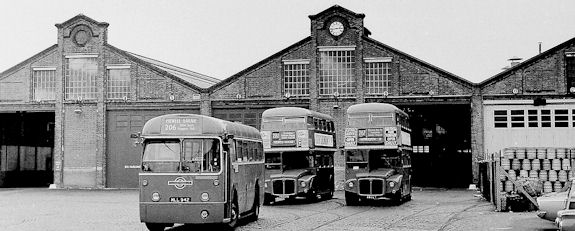
Wellington Road, Twickenham TW2 5NX
The London United Tramways Company intended that Fulwell should be the centre of a vast and great tramway network. Before 1901 all public transport had been horse drawn and each horse drawn bus had needed 11 horses to run a 60 miles per day service. Trams running on rails and powered by electricity were modern, clean, efficient and glamorous. Fulwell Depot was planned to accommodate rolling stock for the lines to Hampton Court, Kingston and Wimbledon, together with proposed lines striking across Hampton Court Bridge taking in a second loop through the Dittons and back to Kingston via Surbiton. Other more ambitious plans to reach Maidenhead and Reading failed to materialise.
Tracks, with a gauge of 4ft 8.5in, were laid along the planned routes. As it was necessary to widen the road in front of Garrick's Villa to make way for the tracks, the house was bought by the London United Tramway Company in 1902 for demolition. Fortunately for future generations, the general manager of the company, Mr (later Sir) J. Clifton Robinson, decided to live there himself. The wall on the Hampton Court side had to be set back to where it is today, but the only other alteration made by the company was the provision of a siding for Mr Clifton Robinson's private tram so that he could be driven directly to and from work. It now houses the Twickenham Museum. The Clifton Robinsons' tenure of Garrick's Villa was marked by great social activity. Flower shows and fetes were held there as well as enormous garden parties for company employees - two thousand being brought in relays by seventeen special tramcars stopping outside the door.
The five and a half acre site off South Road was secured after lengthy negotiations with the owners, Freake Estate Trustees. The site was awkwardly shaped and is best described as a 'cranked rectangle'. A 99 year lease at £200 a year was agreed in April 1902. Building work started without delay. The freehold was eventually bought by the London Passenger Transport Board in 1937.
Apart from the structural steel work and the central heating system, all the work was carried out by company staff. The car shed was built to a decorative style. The elevations present four gabled and pedimented spans, each with space beneath for five tracks. Circular glazed openings are at the top of each gable and in one of these is a large clock. Ten foot walls with stone capped piers form the boundary. Each entrance is guarded by heavy wrought iron gates, with their piers supporting ornamental wrought iron lamp fittings.
The depot was one of the largest in Greater London - 18 tracks with a gauge of 4ft 8.5in. The car shed measured 400 ft by 258 ft and had frontages to and access from both Stanley Road to the east and Wellington Road to the west. Of the eighteen tracks in the car shed, fifteen accommodated 165 tram cars. The remaining three were used as a repair shop accommodating 24 tram cars undergoing maintenance work. In 1929 Fulwell received a tram car washing machine. Surplus, open-top trams were broken up in the east yard, known as the ‘˜boneyard'. The depot also accommodated tram cars for Shepherds Bush, Hammersmith and Hampton Court Termini.
In 1930-31 the newly built 'Feltham' type trams were fitted out and painted at the Fulwell Depot. These contrasted favourably with the antique appearance of the earlier trams. Each one was delivered in shell form from the Union Construction Finance Company's works in Feltham, on a road trailer hauled by a steam engine hired from Pickford & Co.
The trams continued to run until 27 October 1935. The first trolley buses in the London area ran from Fulwell depot which became the operating base for these services. Trolley bus capacity was for 120 vehicles.
In the 1950s, operating electric trolley buses was no cheaper than using diesel buses and their environmental benefits were not fully appreciated. London Transport perfected its new diesel bus, the Routemaster (RM) and the entire trolley bus network, once the largest in the world, was scrapped.
Converted in 1962 to a bus garage, Fulwell took in a complement of 60 buses - the double decker Routemasters and the standard single decker bus the RF. When Twickenham garage closed in 1970 their fleet of buses moved to and operated from Fulwell. In the early 1990's the large yard at the rear of the depot was used to store redundant Routemasters awaiting sale.
The building is Listed Grade II.
By road: Off A311, Wellington Road
By rail: Close to Fulwell Railway Station

Barker, T.C., and Robbins, M., A History of London Transport, Allen & Unwin, ISBN-10 0043850634 (1974)
Dunbar, C. S., London's Tramway Subway, LRTL, ISBN-10 0900433523 (1975)
Harley, Robert, London's Tramway Twilight, Capital Transport, ISBN-10 1854142348 (2000)
Harley, Robert, Twickenham and Kingston Tramways, Middleton Press, ISBN-10: 1901706354 (1999)
Joyce, James, London Transport Bus Garages Since 1945, Littlehampton Book Services, ISBN-10: 0711018022 (1988)
Oakley, E. R. and Holland, C. E., London Transport Tramways 1933-1952, London Tramways History Group, ISBN-10 0951300121 (1999)
Reed, John, London's Tramways, Capital Transport, ISBN-10 1854141791 (1997)
Taylor, Sheila, and Green, Oliver, Moving Metropolis: A History of London's Transport Since 1800, Lawrence King, ISBN-10 1856693260 (2003)